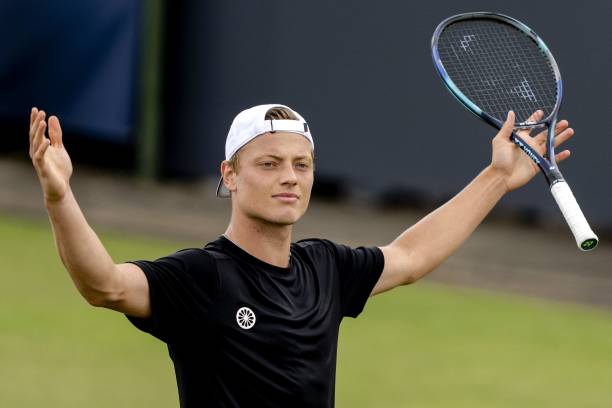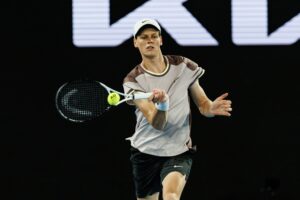Last month, Tim van Rijthoven made every headline in the tennis world by taking the title at the ATP 250 at ‘s-Hertogenbosch. A wildcard rather unknown to the casuals, he somehow managed to upset Daniil Medvedev (then ATP #2), Felix Auger-Aliassime (#9), and Taylor Fritz (#14) in the span of just four days. Winning that trophy also made the Wimbledon organizers offer him a main draw wildcard, which doesn’t happen that often with players not from the country the tournament is held in. The 25-year-old jumped 99 positions in the ATP Rankings (from 205 to 106).
Before ‘s-Hertogenbosch, van Rijthoven had only played one match on the ATP Tour, losing to Jiri Vesely at Winston-Salem in 2016 (as a lucky loser). As one of the more promising Dutchmen, he was given a wild card into Rotterdam qualifying a few times but had never had the same opportunity at the grass-court event in Rosmalen.
Injuries, slowly making Challenger impact
A Top 20 junior back in the day, it took him a while to realize that potential. Almost all of the 2017 season had him out with injuries (he came back in December to play only six matches, and was even out of the ATP Rankings for a couple of weeks). When in 2019 he broke into the Top 300 for the very first time with three ITF titles and a Challenger semifinal in Kobe, he was unlucky to have to sit out most of the COVID-19 destroyed 2020 season again, playing only a handful of events between August and November.
Last year was when the Dutchman began making very consistent impact on the Challenger circuit, reaching his first final in Segovia. His mental resilience was still lacking as he dropped the opening set from 6-1 in the tie-break to Benjamin Bonzi, but the serve and forehand-oriented playstyle was becoming a lot more threatening. He also won one of the most stacked 25K ITF events of the year in Biel, defeating Jiri Lehecka, Arthur Cazaux, Otto Virtanen, Leandro Riedi, and Adrian Andreev. A smaller event on a very fast indoor court in Switzerland, but the quality of the field was pretty insane.
Losing momentum after the indoor season, not hitting a good start on grass
At the beginning of 2022, van Rijthoven was able to make his Grand Slam qualifying debut at the Australian Open (lost in the second round). The serve was somehow starting to become even more threatening in the European Challenger indoor season, leading to him coming close to a title on that circuit again, losing to Jack Draper at Forli. In plenty of these performances, he just wasn’t allowing his rivals any opportunities on return. Instead of staying in Europe for clay, van Rijthoven went to Mexico to play on altitude, but lost in the opening round both times, coming into the French Open without any momentum.
After losing in the final qualifying round to Norbert Gombos, the Dutchman went to Surbiton to play his first professional match on grass. Competing on the lawn for the first time in eight years, he lost to the aforementioned big-serving Otto Virtanen 7-5 in the third. Needless to say, no one was expecting what was about to happen in ‘s-Hertogenbosch, especially as the Dutchman was the underdog in all five matches.
What’s the surprise in van Rijthoven’s grass game?
With a big serve and attacking style of play, van Rijthoven had always had a knack for faster surfaces. Back in his junior career, he made the quarterfinals at Wimbledon but hadn’t competed on the lawn in eight years since then. Something that couldn’t really be predicted was how effective his slice was going to be. Even indoors, it was a shot that van Rijthoven used but it was never a particular strength of his, especially given how his one-handed backhand was perceived as a liability and targeted by the opponents. Grass took his weaker wing and turned it from an impediment to an absolute gamechanger.
Fast, slick conditions not only gave him the ability to produce low, unpleasant balls with the backhand slice, but also helped him avoid constantly getting pinned to that corner and have an easier time dictating with his forehand. Another big factor in the wins against Medvedev, Fritz, and Auger-Aliassime was the block return, which is especially effective on grass. Just like the slice, it doesn’t bounce high and has the opponent hitting from rather uncomfortable positions.
Perfect draw at Wimbledon
Van Rijthoven has been using the same abilities in his Wimbledon campaign so far, taking out Federico Delbonis and Reilly Opelka. Even if it was expected that he might not repeat his ‘s-Hertogenbosch form, which was a concern given his lack of experience, he was very lucky with his spot in the draw. Federico Delbonis had never won a match on grass, coming into Wimbledon with a 0-12 win/loss record. Van Rijthoven struggled for a bit in the opening set, but eventually got a lot more comfortable later on to hand the Argentinian his thirteenth loss.
Reilly Opelka on grass might look like a very tough matchup on paper, but it wasn’t really the case for the Dutchman. The tallest player ever to play tennis professionally, the American doesn’t respond well to being forced to bend his knees extremely low. Van Rijthoven’s slice and chipped returns were just constantly forcing him to do that, taking the American out of his comfort zone.
Still, Opelka is extremely tough to break, but he also didn’t have that much to say on the 25-year-old’s delivery. The Dutchman hit 17 aces, won 90% of his first-serve points, and a particularly impressive 70% on the second serve. Even with his opponent clutching out one tie-breaker with a stunning lob, van Rijthoven won the other two to claim the 6-4 6-7 7-6 7-6 victory.
There’s still potential for more. Van Rijthoven has a very winnable matchup against Nikoloz Basilashvili in the third round, before potentially meeting Novak Djokovic in the last sixteen. To go from being ranked outside the Top 200 to facing the 20-time Grand Slam champion in Wimbledon Round 4 (and arriving there on an eight-match win streak) would truly be something special. But first, he needs to bring his very best again to have a chance at dispatching the experienced Georgian.
Main Photo from Getty.






